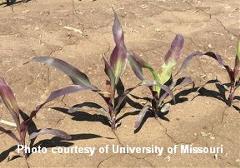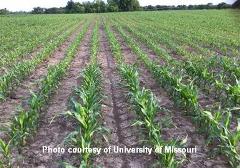AGRONOMICSUPPORT
YOU CAN TAKETO THE FIELD
Fallow Syndrome: What is your plan?
With the challenging spring planting season that many farmers faced throughout the Midwest, a lot of acres did not get planted. In fact, many areas are still wet! This can create a new set of challenges for the spring of 2020 planting. One of those challenge is Fallow Syndrome. Fallow Syndrome is more common in some areas than other. In the sugarbeet growing regions of central Minnesota and the Red River Valley of western Minnesota and eastern North Dakota, it’s quite common.
What is Fallow Syndrome?
Fallow Syndrome is not necessarily a disease, but more of a condition that results from certain environmental factors. It is commonly mistaken for a phosphorus deficiency because the young plants (more commonly found in corn) will turn a bright purple. It is usually found after fields have gone unplanted for a growing season. Fallow Syndrome can be exacerbated by cool and wet field conditions following spring. In the sugarbeet growing areas, it can show up the year following beets because sugarbeets are a non-host crop for the mycorrhizae fungi that is lacking in the soil.
What Causes Fallow Syndrome?
Fallow Syndrome is caused by a lack of a beneficial fungi known as Vesicular Arbuscular Mycorrhizae (VAM). The reduction in the VAM fungi is the result of a lack of a host crop the previous year. The fungi form a symbiotic relationship with the host crop (usually grass crops – corn or small grains) where the fungi feed on the sugars released by the roots and in return the fungi help with the uptake of nutrients, especially phosphorus and zinc. Fallow syndrome can be worsened by cool and wet soils following a year of fallow ground. Soil compaction can also play a role in Fallow Syndrome.
Fields that are showing Fallow Syndrome generally have corn plants that are a purplish color as well as looking stunted and spindly.


Can Fallow Syndrome hurt my yields?
It has been difficult to quantify how much Fallow Syndrome can hurt yields. In extreme cases yield can be significantly reduced, however generally speaking it is not a huge yield robber.
What can I do to lessen the risk Fallow Syndrome? How do I fix it if it goes occur?
There are several things that a producer can do to lessen the risk of Fallow Syndrome. First, planting a cover crop, especially with cereal grains, will significantly reduce to risk of Fallow Syndrome. Just be aware, Brassica crops (forage radish and turnips) are non-host crops for the mycorrhizae fungi and will have little effect on reducing Fallow Syndrome. Hybrid selection can also help, however most seed companies do not rate the corn hybrids for Fallow Syndrome. Some hybrids are more susceptible to the lack of phosphorus than others. Planting soybeans on fallow ground can help, as soybeans are not as susceptible as grass crops are. Adding or increasing the amount of phosphorus liquid fertilizer in furrow at planting can help. Pay attention to the salt levels in your starter fertilizer and placement to avoid burning your seed and reducing your stand.
Once a crop is diagnosed with Fallow Syndrome, there is very little that will fix it. Some people have tried topical applications of phosphorus, but with little result. Some people have used a row crop cultivator to introduce oxygen into the soil profile to stimulate root growth. This has worked well, however there are not many row crop cultivators left.
Conclusion
Fallow Syndrome is a common situation that occurs in fields that have been left idle the previous growing situation. It is caused by a lack of a beneficial fungi known as VAM. This VAM fungi helps with the uptake of nutrients by the plants and can be corrected with different measures. The effect on the yield can vary.
Download a copy of this technical bulletin here: Fallow Syndrome
References and Additional Information:






Technical Team Agronomist